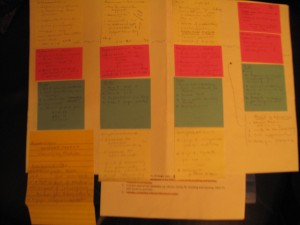Monthly Archives: March 2013
Abstraction pedagogy
Interesting blog post about the challenges youth face in coping with abstractions in learning.
http://www.edutopia.org/blog/teenagers-and-abstract-thinking-shawn-cornally
Crit on Hole-in-the-Wall
From Stephen Downe’s
“Unlike the Nobel Prize, which rewards people for work they’ve done, the TED Prize is basically startup money for work they’re going to do. This with the 2013 prize, which gives Sugata Mitra about $1 million to develop something called School in the Cloud. This recent attention has caused some writers to examine the initiative that made him Gates-worthy in the first place, the ‘hole in the wall’ initiative, where he put computers in public places in India and watched as kids taught themselves how to use them.
Audrey Watters, for example, says people should ask critical quesions, questions about “this history of schooling as Mitra (and others) tell it,” about “the funding of the initial “Hole in the Wall” project (it came from NIIT, an India-based ‘enterprise learning solution’ company that offers 2- and 4-year IT diplomas),” questions “about these commercial interests in ‘child-driven education’.”
Donald Clark assails Mitra’s work. “‘What we see is the idea of free learning going into free fall’ said Payal Arora. When Arora came across these two ‘hole-in-the-wall’ sites, accidentally in India, she discovered not the positive tales of self-directed learning but failure.”
Mike Caulfield offers heretical thoughts. “Mitra’s got a bad case of straw man disease here, but the most striking thing about his exposition is that he seems to believe our educational system was invented a specific time to solve a well-defined, identifiable problem: the production of clerical workers.”
I’m not as critical as they about the concept of what Mitra calls self-organized learning. After all, that’s pretty much what I’m up to. But I don’t think learning will be reformed from the top down with TED talks and Gates grants, because I have my doubts that the learning provided by the corporations of today will be any more enlightened tghan the learning created to serve the needs of corporations in Victorian England. (Photo: what’s left of the ‘hole in the wall’ project. Via Donald Clark.)”
http://donaldclarkplanb.blogspot.ca/2013/03/sugata-mitra-slum-chic-7-reasons-for.html
http://www.rimwe.com/the-solver-blog/28.html?goback=%2Egde_934617_member_226570124
Learning analytics … questions
”
Explanatory vs. Predictive
How does a good teacher know if a student is struggling with a concept in the classroom? We hope that they recognize signs of difficulty while reviewing practice work or are asked for assistance by the student (feedback, hints). If learning analytics are going to provide useful feedback then we should be measuring those feedbacks and requests for help. A click stream tells me if a student is using material but not why or what that interaction ought to achieve. A student might skip problems they already know – their lack of answering questions in a particular part of the course is not itself evidence of lack of understanding. Similarly, a student can struggle while working very hard to try and understand a concept. Their mere frequency of interaction does not in any way imply instructional success. Only knowing their clicks, or visits, tells us nothing about their intent, when they wanted help, if they got that help, or what feedback they were given (or should have been given). Consider the following questions one might want to ask:
- How often is the student getting questions right on the first try?
- Do they eventually get them correct?
- How often are they asking for help?
- Do expert teachers rate this skill is generally difficult?”
http://mfeldstein.com/if-you-like-learning-could-i-recommend-analytics/
Bill Latta’s Course Design
Thanks to Bill Latta for his thoughtful and helpful presentation March 13.
Click Improving Our Practice Together to download a copy of his paper.
Click Improving Practice Workshop to download his presentation.
Crichton – Designing Instruction
Gagne’s Events …
|

